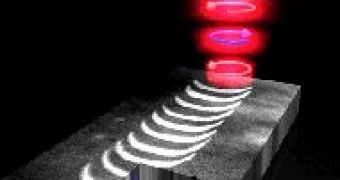The conventional design of a hard disk drive calls for a read/ write head to modify the magnetic field of a certain memory bit in order to modify its stored value and thus information. While this method has been in use for decades and it is reliable and quite fast, researchers from the Netherlands and Japan tried a different approach to flip the magnetic field of a memory bit without using a classical hard disk drive head. Instead they used a laser to fire a very short pulse of circularly-polarized light at the recording surface and thus change the value of a memory bit.
This method has a series of advantages over the traditional method of altering the magnetic field of a memory cell, notably it is around 50,000 times faster than the classical methods now used in the magneto-optic data storage systems. This simply means that the old and tired hard disk drive may receive an incredible boost of performance. The information is stored in a binary form on the surface of the disk and it is represented by the direction of the magnetic field in a certain region of the disk. Researchers from the Radboud University Nijmegen in the Netherlands together with those from the Nihon University in Japan demonstrated the new technology by reversing the polarity of the magnetic field of a single 5 micron wide on a thin magnetic film. While there are a number of technologies around that can use a light laser beam in order to read bits of data from a traditional hard disk drive recording surface, the new technology can also be used to write data on the recording surface.
While this technology can deliver some important advantages over the traditional method, there are a number of problems that still have to be resolved as the recording surface is much wider than the surface normally used by a standard magnetic drive. This directly translates into increased speeds at the expense of data density so the potential commercial drives which may use this technology may very well come with much smaller storage capabilities. One other problem is the light pulse itself, or more exactly the generating device as such a device is very expensive and will increase the total cost of the storage drive above the affordable level of an average computer user.
While until now most experiments were done using conventional materials like iron, cobalt and so on scientists are now trying to find materials with higher density in order to preserve the storage level achieved when using conventional design hard disk drives. In the near future such laser driven hard disks may compete against solid state drives which are now an almost viable alternative to the classical HDD design.

 14 DAY TRIAL //
14 DAY TRIAL //